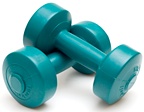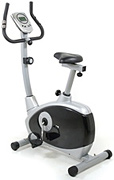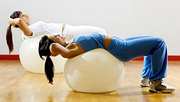Body by Design
By Dr. Daniel J. Cruoglio
When you walk into a gym, there is a different contraption in every corner promising results. But of course, not all exercise equipment provides the same type of workout. Should you use the treadmill, bicycle, free weights or exercise ball to get the results you're looking for? Get the answers you need to maximize your fitness efforts. Putting together a successful health and fitness program can be easy once you know what goals you want to achieve and then take the action steps to make it happen. Whether your goals are to lose weight, build more muscle or just get in good physical condition, you will find the following information valuable in helping you get started. There are three things that are essential for designing your ideal body: proper diet, resistive training and cardiovascular training. Having knowledge in each of these areas will help when it comes to designing your program. 1. Proper Diet
 The saying "You are what you eat" is certainly true if you are not providing your body with the proper nourishment it needs for you to function at your optimal level. Dr. James Chestnut, author of The 14 Foundational Premises, The Innate Diet, Innate Physical Fitness and The Innate State of Mind, says we are either deficient or toxic. We are either putting things into our body that are not good for us or we are depriving our body of the vitamins and minerals it needs to sustain us. In any workout it is important to drink water because it helps to prevent headaches and cramping, as well as to maintain your energy level. When doing resistance training, it is important to ingest protein within 30 to 60 minutes of a workout so the muscle can undergo growth and recovery. Protein should consist of eggs, chicken, fish and lean beef. When shopping for beef, it is always better to buy grass-fed rather than grain-fed beef. Good fats such as omega-3s, which can be found in cold-water fish like salmon, and good carbohydrates like those found in fruits and vegetables, are essential in overall function. For more information on diet and proper nutrition, consult with your chiropractor.
The saying "You are what you eat" is certainly true if you are not providing your body with the proper nourishment it needs for you to function at your optimal level. Dr. James Chestnut, author of The 14 Foundational Premises, The Innate Diet, Innate Physical Fitness and The Innate State of Mind, says we are either deficient or toxic. We are either putting things into our body that are not good for us or we are depriving our body of the vitamins and minerals it needs to sustain us. In any workout it is important to drink water because it helps to prevent headaches and cramping, as well as to maintain your energy level. When doing resistance training, it is important to ingest protein within 30 to 60 minutes of a workout so the muscle can undergo growth and recovery. Protein should consist of eggs, chicken, fish and lean beef. When shopping for beef, it is always better to buy grass-fed rather than grain-fed beef. Good fats such as omega-3s, which can be found in cold-water fish like salmon, and good carbohydrates like those found in fruits and vegetables, are essential in overall function. For more information on diet and proper nutrition, consult with your chiropractor. 2. Resistive Training
 Deciding whether to work out with free weights or plate-loaded machines will be determined by what you actually want to accomplish. Each one has its pros and cons. When using free weights, you will be working not only the intended muscle but also the stabilizing muscles. For example, when doing a bench press you are working the chest muscles, but in order to accomplish that movement you will be activating the triceps and rotator cuff muscles which are stabilizing the movement to prevent buckling. Free weights are an excellent way to increase overall function as you increase your strength. Because you are also using the stabilizing muscles, you are not going to be lifting as much weight as you would with the weight machines.
Deciding whether to work out with free weights or plate-loaded machines will be determined by what you actually want to accomplish. Each one has its pros and cons. When using free weights, you will be working not only the intended muscle but also the stabilizing muscles. For example, when doing a bench press you are working the chest muscles, but in order to accomplish that movement you will be activating the triceps and rotator cuff muscles which are stabilizing the movement to prevent buckling. Free weights are an excellent way to increase overall function as you increase your strength. Because you are also using the stabilizing muscles, you are not going to be lifting as much weight as you would with the weight machines. The weight machines are designed to isolate the intended target muscle and thus not get the stabilizing muscles involved. As a result, you will be able to lift more weight with the weight machine than you would with the free weights. So if you are looking to increase your strength and develop a specific muscle, the weight machine is your choice. If you are looking to rehab an injury or develop proprioception, balance and strength, free weights will be the way to go. If you are a beginner or have an injury, utilizing exercise bands and balls is a great way to develop function at a low intensity. You can increase the resistance in the bands as you start to improve. If you cannot perform between 10-12 reps with good form, the resistance is too much and should be reduced to a more manageable level. 3. Cardiovascular Training Cardiovascular exercise involves the heart and lungs, and is critical in maintaining a healthy lifestyle. There are a few things to consider when doing cardio: which exercise is selected and the frequency, duration and intensity of the exercise.
 There are many types of equipment that will give you a great cardio workout - the treadmill, stair climber, elliptical and bicycle. It is recommended that you engage in some form of cardio just about every day. The duration can vary, with a minimum of 30 minutes for each session. It is always prudent to start off slow and increase your intensity as you become more fit. The elliptical is good for anyone who has a knee injury because it provides a low-impact workout. The treadmill, stair climber and bicycle can be used at many different intensity levels. For example, by raising the speed and incline on the treadmill, you increase the intensity of the workout. Increasing the speed with the stair climber and increasing the resistance on the bike and elliptical are great ways to intensify your workout.
There are many types of equipment that will give you a great cardio workout - the treadmill, stair climber, elliptical and bicycle. It is recommended that you engage in some form of cardio just about every day. The duration can vary, with a minimum of 30 minutes for each session. It is always prudent to start off slow and increase your intensity as you become more fit. The elliptical is good for anyone who has a knee injury because it provides a low-impact workout. The treadmill, stair climber and bicycle can be used at many different intensity levels. For example, by raising the speed and incline on the treadmill, you increase the intensity of the workout. Increasing the speed with the stair climber and increasing the resistance on the bike and elliptical are great ways to intensify your workout. Even though you should do cardio every day (even a brisk walk), limit intense cardio training to only 2-3 times per week. When doing high-intensity interval training, spinning or heavy-duty elliptical work, your body can cross the anaerobic threshold and can no longer metabolize blood lactate fast enough. The blood lactate level rises suddenly, resulting in a buildup that is detrimental to muscle tissue, function and recovery. If recovery time is not sufficient, you are overtraining, which is counterproductive.
 Because our office is in a health club, we have seen it all. People in general don't have a clue as to what to do. That's why it is important to seek some professional advice before starting any fitness routine. You could have postural imbalances (like one shoulder or hip higher on one side or having your head far out in front of the rest of your body). By working out on weight machines, you end up creating more of an imbalance because the stronger muscles get stronger and the weak muscles get weaker. This leads to poor results, frustration and eventually quitting and giving up on something that is so important to maintain good health.
Because our office is in a health club, we have seen it all. People in general don't have a clue as to what to do. That's why it is important to seek some professional advice before starting any fitness routine. You could have postural imbalances (like one shoulder or hip higher on one side or having your head far out in front of the rest of your body). By working out on weight machines, you end up creating more of an imbalance because the stronger muscles get stronger and the weak muscles get weaker. This leads to poor results, frustration and eventually quitting and giving up on something that is so important to maintain good health. No matter what your goals are, start off slow. Use resistance bands and stability balls, and then progress to free weights. Then you can utilize the weight machines to define certain areas. Most of all, have fun exercising. Change your routine often - it is good for your body and it also prevents boredom. Even when doing your cardio workouts, change from the bike to the elliptical to the stair climber to the treadmill. Remember, the real secret is to eat less and exercise more.
Daniel J. Cruoglio, DC, has been in practice for 27 years. He is a senior coach for a chiropractic coaching company and a director of a multidisciplinary clinic which integrates chiropractic along with active care and exercise, located in Brick, N.J.
Page printed from:
http://www.toyourhealth.com/mpacms/tyh/article.php?id=1001&no_paginate=true&no_b=true
| 
